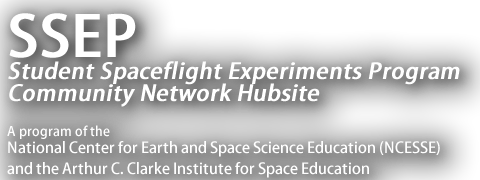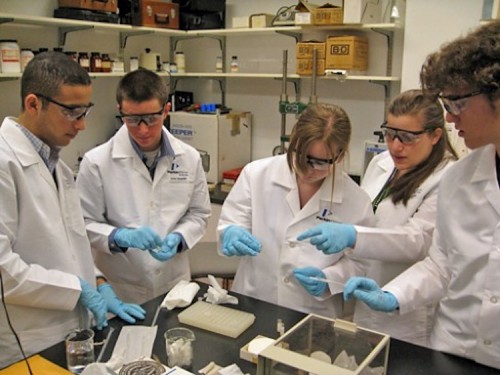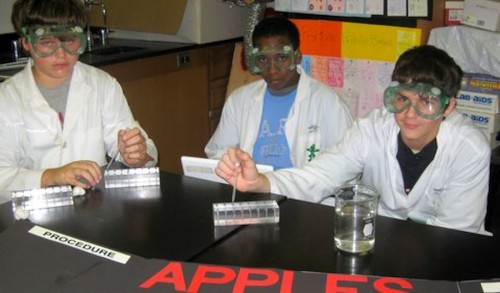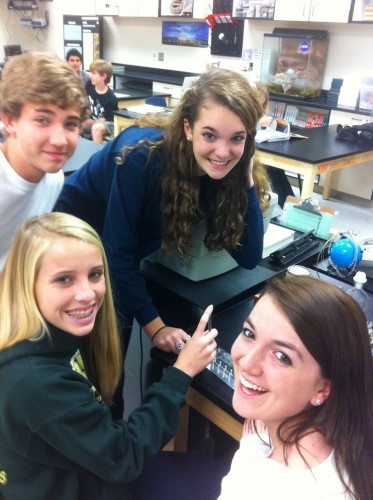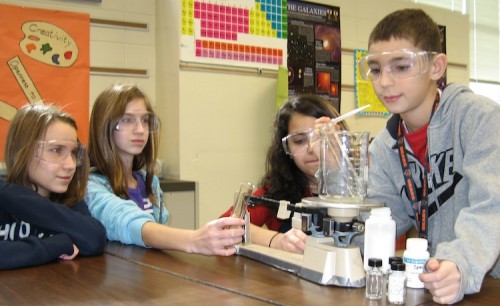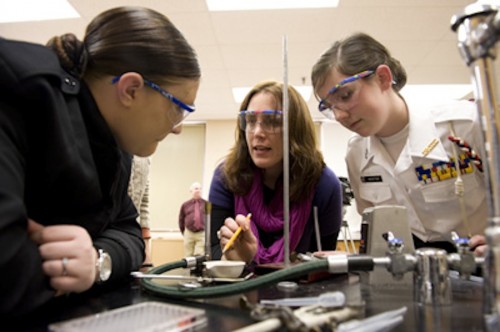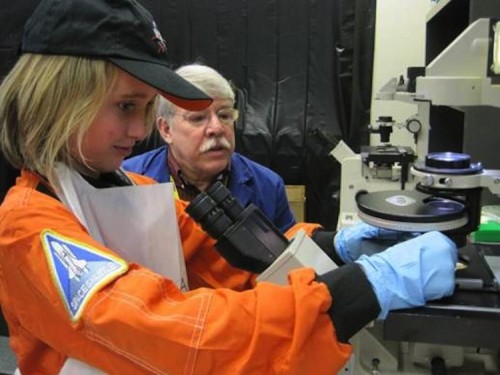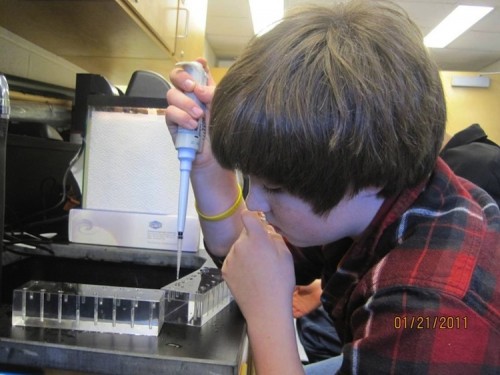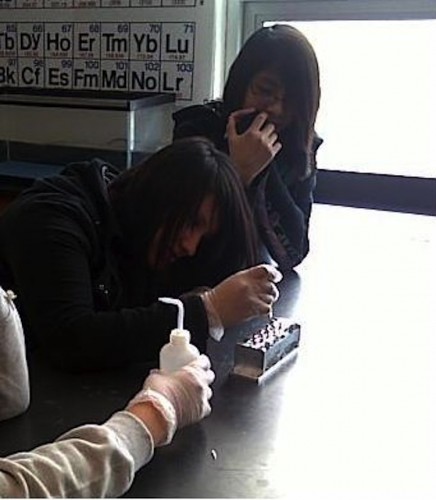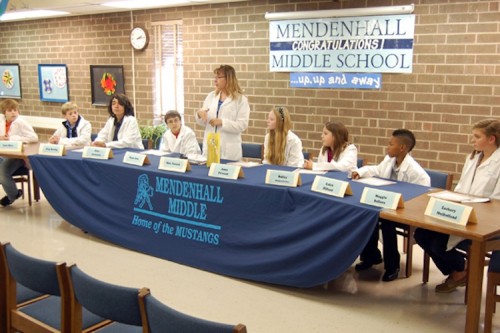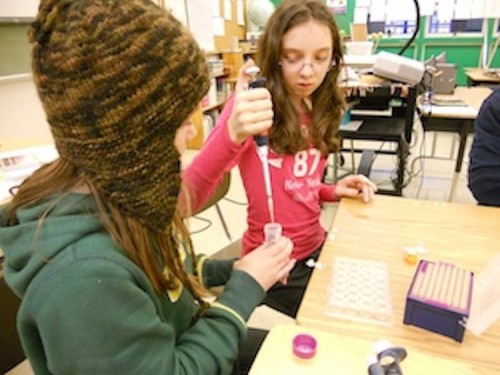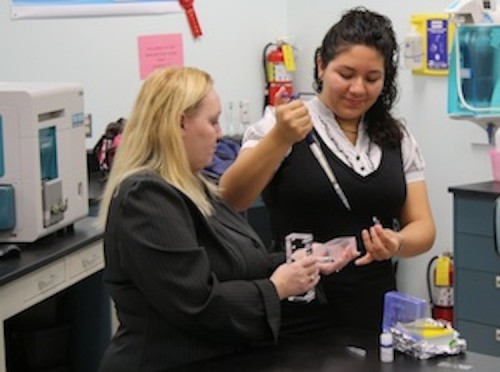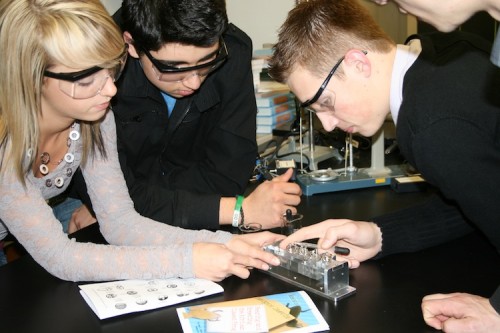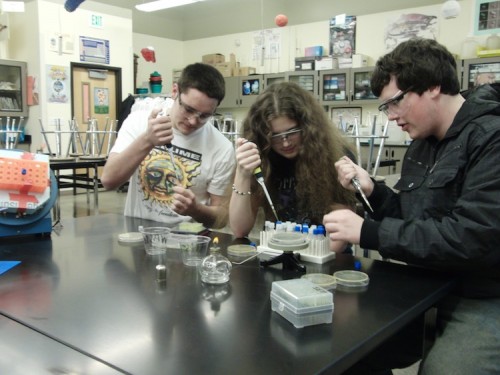The Student Spaceflight Experiments Program is proud (and stunned) to report that there were a total of 447 proposals submitted from student teams across the 16 communities participating in SSEP on STS-134. Of those, 293 proposals were put forward for review by Step 1 Review Boards in each of the communities. Each Step 1 Review Board selected up to three finalist proposals, which were submitted to the National SSEP Step 2 Review Board. On November 22 and 23, 2010, the Step 2 Review Board reviewed all 43 finalist proposals, and selected one proposal to fly for each community, for a total of 16 flight experiments. Meet the SSEP Step 2 Review Board members for STS-134.
This page, which lists all 43 finalist proposals, and describes the 16 selected for flight, is reprinted from the November 30, 2010 SSEP National Blog Post. The Post began with a message from Dr. Jeff Goldstein, SSEP National Program Director, and NCESSE Center Director, titled: To America’s Next Generation of Scientists and Engineers. You can read the message HERE.
Congratulations to the thousands of students and their teachers participating in the Student Spaceflight Experiments Program for the final flight of Shuttle Endeavour. Well done!
1. Shelton, Connecticut
Jump to Shelton’s Community Profile
SELECTED FOR FLIGHT:
Development of Prokaryotic Cell Walls in Microgravity
Grade 12, Shelton High School
Co-Principal Investigators: Leann Misencik, Kayla Russo, Jason Shnipes, Omar Sobh, and James Szabo
Teacher Facilitator: Mary Clark, Head of Science Department
Proposal Summary:
The space shuttle STS-134 will contain a controlled environment with ideal microgravity, in which we can grow bacteria to test the effect of microgravity on the development of a prokaryotic cell wall. The purpose of the experiment is to observe the effect of microgravity on the development and integrity of the cell wall. The bacteria, bacillus thuringiensis, will initially be contained in agar. On the first day, the test tube containing the bacillus thuringiensis will be mixed with the test tube containing a Luria broth medium. This will allow the bacteria to grow in the microgravity environment for ten days. Simultaneously, we will be growing bacteria on Earth, in a controlled environment with standard gravity. After both samples of bacteria have grown for ten days, we will observe samples of the bacteria grown in each environment, under an electron microscope. We will specifically record any observable differences in cell wall structure. Then, we will plate the bacterial samples on nutrient agar. In a sterilized lab on Earth, we will introduce to each culture a small amount of ampicillin, proportional to the optical density of the culture, as recorded by a nanospectrometer. We will observe the growth of each culture. After a set period of time, we will measure the growth of the cultures by calculating the change in area of bacterial growth of each bacterial culture. If we observe differences in these results, then we can conclude that microgravity had an effect on the integrity of prokaryotic cell wall structure.
HONORABLE MENTION FINALISTS:
The Effects of Microgravity on the Biochemical and Cellular Makeup of Escherichia Coli
Grade 12, Shelton High School
Principal Investigator: Corey Ann Chapin
Teacher Facilitator: Patricia Presutto, Chemistry Teacher
Is the growth rate and bacterial resistance of Chromobacterium violaceum ATTC 12472 produced in Nutrient Agar affected by the exposure to microgravity for the duration of ten days?
Grade 11, Shelton High School
Principal Investigator: Anna Maria Marini
Collaborators: Paul Barboni, Angela Marino, and Denise Fix
Teacher Facilitator: Patricia Presutto, Chemistry Teacher
2. Broward County, Florida
Jump to Broward County’s Community Profile
SELECTED FOR FLIGHT:
Apples in Space
Grade 8, Crystal Lake Middle School
Co-Principal Investigator: Devin Blem
Co-Investigators: Yanik Berment and Jonathan Jarboe
Teacher Facilitator: Ms. Keefe, Science Teacher
Proposal Summary:
For our experiment, we are going to allow two apple seeds to germinate, one on the shuttle and one on earth in controlled conditions. After the germination process and both seeds are back on earth, they will be planted. They will be grown in the exact same conditions with the same water intake and sunlight. Their growth will be closely recorded and compared. After they have grown a reasonable amount of time, their height will be compared, as well as their pH levels.
HONORABLE MENTION FINALISTS:
Bactria mutations in sub gravity
Grade 8, Crystal Lake Middle School
Principal Investigator: Dillon Skelley
Teacher Facilitator: Tracy Rice, Science Teacher
Can Oil and Water mix in Micro-Gravity?
Grade 8, Crystal Lake Middle School
Principal Investigator: Akiva Green
Co-Investigator: David Alicea
Teacher Facilitator: Melissa Keefe, Science Teacher
3. Orange County, Florida
Jump to Orange County’s Community Profile
SELECTED FOR FLIGHT:
The Effect of Microgravity on the Ability of Ethanol to Kill E. Coli
Grade 8, Maitland Middle School
Co-Principal Investigators: Kaitlyn Confer, Garrett Gentle, Adelia Heidrich, Abbygail O’Brien, and Jared Persons
Co-Investigators: Peter Barzola, Lucy Greer, Cassidy Livingston, Roche Pretorius, Thomas Sowards, and Emily Vanderburg
Collaborators: Jordan Goslin, Ayana St. Jean, Madison Kerben, Jessica Lanier, Molly McGuigan, Cindy Menendez, Lauren Milgrim, and Ny-Kera Williams
Teacher Facilitator: Lynn Mederos, Science Teacher
Proposal Summary:
The purpose of this experiment is to determine if ethanol will be able to kill Escherichia coli (E.coli) in micro-gravity. Hand sanitizers containing ethanol are good substitutes for soap and water. Since water is in short supply in space environments ethanol might be a good way to maintain hygiene. This experiment will determine if ethanol kills E. coli in space as well as it does in Earth’s gravity.
Ethanol is found in alcoholic beverages, gasoline, mouthwashes, and many other common cleaning materials. This experiment will use Madeira wine as a source of ethanol because it is found on the Master List of Experimental Samples and because Madeira wine has a relatively high concentration of ethanol. E.coli is a bacteria which lives symbiotically in the human colon; but when it is injected, E.coli causes a food poisoning which can be deadly. After exposure to E.coli, it takes roughly 7 days to begin seeing symptoms. The symptoms involve cramps, headaches, nausea, dehydration, and bloody diarrhea. There is not a good treatment for E.coli food poisoning besides drinking plenty of water.
If this study proves that ethanol can kill E.coli in microgravity, it may provide future astronauts with a waterless way to disinfect their hands and living quarters. This will protect the health of astronauts and prevent or reduce infections in the space shuttle environment.
HONORABLE MENTION FINALISTS:
Differentiation of Stem Cells in Microgravity
Grade 8, Glenridge Middle School
Co-Principal Investigators: Anna Johnson and Zach Webb
Co-Investigators: Kaylyn Dere and Alyssa Ewing
Collaborators: Pilar Brooks, Jordan Lewis, and Kylie Walls
Teacher Facilitator: Carolyn Adams, Science Teacher
The Effect of Micro-Gravity on H1 Embryonic Mouse Stem Cells Grown in Human Leukemia Inhibitory Factor
Grade 8, Maitland Middle School
Co-Principal Investigators: Jenna Adamczak, Sam Bogle, Halle Bryan, and Sara Nazarian
Co-Investigators: Baron Hahn, Hannah Madison, and Angelina Razzani
Collaborators: Andy Bell, Christian Gould, and John Ryan
Teacher Facilitator: Lynn Mederos, Science Teacher
4. Lincolnwood, Illinois
Jump to Lincolnwood’s Community Profile
SELECTED FOR FLIGHT:
Efficiency of Microencapsulation in Microgravity as Compared to Gravity
Grade 6, Lincoln Hall Middle School
Principal Investigator: Brandon Gligor
Teacher Facilitator: Sharon Churchwell, NBCT, Science Teacher and Gifted Education Specialist
Proposal Summary:
This proposal will examine the efficiency of microencapsulation in the microgravity environment of space and compare it to the efficiency of microencapsulation in the gravity environment on Earth. I propose that the drug particles coated in microgravity will have a thicker coating and therefore a larger size and greater mass than the drug particles coated in gravity. I also propose that the coating will be more uniform on the particles formed in microgravity because the particles will stay in suspension longer and not touch each other as much in microgravity as in gravity so then the coating can form evenly on all sides of the drug particles. I want to see if drug particles can be coated by using a solvent and an anti-solvent. The solvent is going to be PVP, and PVA will be dissolved into the PVP. Then water with the drug particles suspended in it will be added, and the water should make the PVA come out of solution. This happens because water is an anti-solvent so it forces the PVA, which is not soluble in water, to come out of solution. The PVA that has come out of solution can possibly make a new particle, coat the wall of the chamber, or deposit on drug particles of ciprofloxacin. The drug particles will be measured, using equipment at AVEKA Group, before treatment and then after treatment in gravity and after treatment in microgravity.
HONORABLE MENTION FINALISTS:
Development of Medaka Fish Eggs in Microgravity as Compared to Earth
Grade 7, Lincoln Hall Middle School
Principal Investigator: Mrugami Mahadik
Teacher Facilitator: Sharon Churchwell, NBCT, Science Teacher and Gifted Education Specialist
Do antibiotics kill more germs in microgravity than in gravity?
Grade 8; Lincoln Hall Middle School
Co-Principal Investigators: Shayne Snyder and Austin Gonzalez
Teacher Facilitator: Sharon Churchwell, NBCT, Science Teacher and Gifted Education Specialist
5. Jefferson County, Kentucky
Jump to Jefferson County’s Community Profile
SELECTED FOR FLIGHT:
The Effect of Micro-gravity on the Viability of Lactobacillus GG
Grades 9, 10, and 11, The Academy @Shawnee
Principal Investigator: Jade Burton
Co-Investigators: Ben Bommarrito, Alejandro Cid, Miranda Fitz, Cody Harral, Ashleigh Keister, and Amber Walters
Teacher Facilitator: Imogen Herrick, Science Teacher
Proposal Summary:
NASA started the Health Stabilization Program that helps prevent sickness in space. Despite demonstrated effectiveness in cosmonauts, the NASA program does not use probiotics. A probiotics is a bacterium that benefits its host. Probiotics are found in dairy products and our digestive tract, where we have about 10^14 bacteria. Probiotics also help with homeostasis, the balance in our body systems.
Our experiment proposes to study the effect of micro-gravity on the viability of Lactobacillus GG, a probiotic. Lactobacillus GG is used as a preservative to keep dairy products fresh. It is present in yogurt and assists our body with digestion.
Our procedure consists of exposing Lactobacillus GG to micro-gravity and counting colonies when it returns to Earth. This will allow us to determine the viability of Lactobacillus GG in micro-gravity conditions.
Understanding the viability of probiotics in microgravity can promote longer space missions without risking the health of astronauts. In the future, probiotics would be a useful tool in promoting health for people in space. In the meantime, NASA could include probiotics in the Health Stabilization Program. This could prevent more sicknesses and improve digestion in space.
6. Zachary, Louisiana
Jump to Zachary’s Community Profile
SELECTED FOR FLIGHT:
What is the Effect of Microgravity on the Growth Rate of Murine Myoblasts?
Grade 5, Copper Mill Elementary School
Co-Principal Investigators: Alexis Albert, Grace Dry, Madison Russell, and Leanne Sorrel
Co-Investigators: Tyler Jackson and Jake O’Brien
Teacher Facilitator: Circe Bridges
Proposal Summary:
Experimenters will see how microgravity affects the growth rate of murine myoblasts isolated from adult mice. They will use the following materials and tools: two MDA Type 1 wells, eight murine myoblasts, a pipette to transfer myoblasts, a microscope, and a glucose solution. The wells provide a base for the experiment. The murine myoblasts, which will be transferred with the pipette, are the test indicators. The microscope will be used to see changes in size and number of the myoblasts. The myoblasts size will be measured before transfer into the MDA Type 1 wells. A solution of glucose and distilled water will be added to the wells as a nutrient base. One well will be exposed to microgravity and one will remain in Earth’s gravitational pull as control. After ten days, the myoblasts in both wells will be compared in size and number. The results of this research are important due to the increasing need of cell research application.
HONORABLE MENTION FINALISTS:
Frog Embryo Development in Microgravity
Grades 11 and 12, Zachary High School
Co-Principal Investigators: Chao Li and Jeanell Varnadore
Co-Investigators: Brennan Biggs, Josh Crawford, Charlie Flanders, Kaylee Garlington, Derek Hanson, Jacob Kuhns, Alex Rivere, Anthony Russell, and Austin Walker
Teacher Facilitator: Jay Call, Physics/Astronomy Teacher
Bacteria Growth and Conjugation in Microgravity
Grade 11 and 12, Zachary High School
Co-Principal Investigators: Chao Li, Evan Rivere, and Melissa Sullivan
Collaborators: Brittany Castello, Jordan Conques, Morgan Cook, Christopher Van Diver, Candace Franklin, Haley Guillot, Bryan Allen-Heikes, Yue Li, Luke Lowery, Emily Mann, Tiffany Nelson, Madeline Pipkin, Jonathan Spillman, and Zach Wigger
Teacher Facilitator: Catherine Raziano, AP Biology Teacher
7. Saint Mary’s County, Maryland
Jump to Saint Mary’s Community Profile
SELECTED FOR FLIGHT:
Swimming Patterns and Development of Zebra Fish after Exposure to Microgravity
Grade 8, Esperanza Middle School
Co-Principal Investigators: Abisha Dowla, Noah Fletcher, Josh, Mulhern, and Mirelle Patrey
Teacher Facilitator: Mrs. Lewis, 8th Grade Science Teacher
Proposal Summary:
As an experimental springboard for future food sources, we would like to test the development of fish in microgravity conditions. If there were developmental problems in the fish, we could then hypothesize that the microgravity conditions would not be a safe spawning environment for the fish. To test this, we would expose zebra fish (Danio rerio) embryos to microgravity and then justify our hypothesis based on the behavior and development of the hatched embryos. With this information we can infer and test multiple varieties of larger fish in the future as a means of food for the astronauts. We can also use the information gathered from the zebra fish to conclude whether or not microgravity conditions are an adequate environment for farming and developing fish.
HONORABLE MENTION FINALISTS:
The Effect of Gravity on Mouse Embryonic Stem Cells
Grade 9, Great Mill High School
Co-Principal Investigators: Katie Jahn, Sonia Lee, and Casey Scheetz
Teacher Facilitator: Rhonda Morgan, Chemistry Teacher
Effects of Digestion in a Microgravity Setting
Grades 11 and 5, Great Mills High School
Principal Investigator: Molly Tracy (Grade 11)
Co-Investigators: Kelles Gordge (Grade 11) and Jay Tracy (Grade 5)
Collaborator: Taylor Nelson (Grade 11)
Teacher Facilitator: Rhonda Morgan, Chemistry Teacher
8. Harry A. Burke High School, Omaha, Nebraska
Jump to HABHS’s Community Profile
SELECTED FOR FLIGHT:
Honey as a Preservative on Long Duration Space Flights
Grade 10, Harry A. Burke High School
Principal Investigator: Aaron Zipursky
Teacher Facilitator: Amy Melvin, Honors, AP Chemistry/AP Physics teacher
Proposal Summary:
On Earth, honey can last hundreds of years without spoiling, and has been used to effectively preserve various other products for decades at a time. As NASA scientists and engineers plan a future trip to Mars, one of the biggest problems is finding a way to store enough food for the astronauts to eat on the extremely long trip. One potentially useful preservative is honey. While it has proven a useful preservative for products on Earth, can honey prevent raw foods from spoiling while in space? If honey has the same preserving powers in space that it does on Earth, it could be a very serious prospect for preserving food from going bad while on long duration space flights.
HONORABLE MENTION FINALISTS:
Observation of Lactobacillus Bacteria in Microgravity
Grades 11 and 12, Burke High School
Teacher Facilitator: Amy Melvin, Honors, AP Chemistry/AP Physics teacher
Strawberry Seed in Mars like Soil
Grade 12, Burke High School
Teacher Facilitator: Amy Melvin, Honors, AP Chemistry/AP Physics teacher
Brine Shrimp Flight Experiment
Grade 12, Burke High School
Teacher Facilitator: Amy Melvin, Honors, AP Chemistry/AP Physics teacher
9. Omaha North High Magnet School, Omaha, Nebraska
Jump to NHMS’s Community Profile
SELECTED FOR FLIGHT:
Effects of Microgravity on Lysozyme’s Antibacterial Properties
Grade 12, Omaha North High Magnet School
Co-Principal Investigators: Dan Burgdorf, Jesse Epperson, Jessica Powell-Lafond, and David Smiley
Teacher Facilitator: Susan Loder, Chemistry Teacher
Proposal Summary:
The purpose of our experiment is to determine how microgravity affects lysozyme’s antibacterial properties. Lysozyme is an enzyme that occurs naturally in secretions such as tears, saliva, mucus, and human milk. It is also found in plant and animal tissues, such as egg whites. Lyzosyme protects against Salmonella, E. coli, and Pseudomonas, thus it is a crucial part of the natural immune system.
Because lysozyme is so important, it is critical that we understand how space travel and microgravity affect its antibacterial properties. Although there is little threat of bacterial exposure in space right now, the threat will increase as larger numbers of people engage in space travel. If lysozyme’s antibacterial properties are decreased under microgravity, then humans will need a different form of protection in the secretions listed above. If the properties are increased, then lysozyme could be used to combat stronger forms of bacteria.
We will test lysozyme’s antibacterial properties on E. coli K-12 and determine if lysozyme subjected to microgravity becomes denatured. To test the antibacterial properties, we will grow lawns of E. coli K-12 on agar plates, then streak each plate with lysozyme. There will be three types of lysozyme samples: one subjected to microgravity and two ground truth samples. To determine if the lysozyme was denatured, we will perform Thin Layer Chromatography on each of the three samples.
HONORABLE MENTION FINALISTS:
Cellular Reproduction in Microgravity
Grade 12, 10, and 9, Omaha North High Magnet School
Teacher Facilitator: Elaine Westbrook, Science Educator
The Effect Gravity Has on the Hatching of Brine Shrimp
Grade 9 and 11, Omaha North High Magnet School
Teacher Facilitator: Elaine Westbrook, Science Educator
10. Central Consolidated School District, New Mexico
Jump to CCSD’s Community Profile
SELECTED FOR FLIGHT:
Does the Radiation exposure effect seed germination without the protection of the ozone layer?
Grade 8, Tse Bit ai Middle School
Co-Principal Investigators: Micah Devore, Adrianna Nicolay, and Crystal Yazzie
Co-Investigators: Tabitha Castillo, Alexandria Holiday, Kendrick Joey Jr., and Miracle Russell
Collaborators: Ethan Aspaas, Vanessa Barber, Chance Begay, Melissa Begay, Summer Begay, Zachary Begay, Brennan Benally, Wyatt Billy, Summer Charley, Malachi Clah-Deale, Aubree Clark, Shante Cohoe, Alejandro Cota, Kristen Deel, Duran Denetsone, Tywauna Draper, Chevonne Etcitty, Talia Guerra, Fernando Gutierrez, Lisa Harry, Steven Hastings, Abraham Hobson, Rookie Hoskie, Brandon Jim, Dakota Jim, Ashley Joe, Arianna John, Adam Johnson, Megan Johnson, Rylynn Johnson, Kateri Lee, Michelle Lee, Danielle Nelson, Brittany Poyer, Norman Sam, Madison Shorty, Orion Smith, William Todacheenie, Jack Tome, Alexus Uentillie, Kaylin Walters, Tinisha Wilson, Franklin Yazzie, and Sierra Yessilth
Teacher Facilitator: Amy J. John, 8th grade Science Teacher
Proposal Summary:
In New Mexico, plants and seeds are exposed to a small amount of natural radiation that it wouldn’t have any effect on their germination process. If the seeds were exposed to higher radiation without the protection of the ozone layer, would the ionizing radiation at high levels cause a decrease or increase sprouting and speed up or slow down seedling growth of the seeds. A Geiger counter will be in place to verify the radiation level reading to determine a difference in space and Earth.
11. Ballston Spa Central School District, New York
Jump to Ballston Spa’s Community Profile
SELECTED FOR FLIGHT:
The Development of Minnow Fish Eggs in Space
Grade 5, Milton Terrace South Elementary School
Co-Principal Investigators: Dana Betti, Jordyn Catherall, and Kate Yager
Teacher Facilitator: Angelo D’Annibale, 5th Grade Teacher
Proposal Summary:
Our experiment is how a lack of gravity effects the development of Minnow fish eggs. Our team will be conducting this experiment to prove or not prove our theory. First, materials will be gathered and placed in a test tube. Then, the test tube will be sent in a chamber to space. After, we will calculate and graph results as stated in this proposal.
HONORABLE MENTION FINALISTS:
The Effect of Microgravity on Bacterial Reproduction
Grade 9, Ballston Spa High School
Principal Investigator: Troy Mackey
Teacher Facilitator: Mary Lue Stern, Biology Teacher
Affect of Penicillin in Microgravity
Grade 11, Ballston Spa High School
Principal Investigator: Denise Croote
Teacher Facilitator: Mary Ellen Kusnierz, Science Teacher
12. Guilford County, North Carolina
Jump to Guilford County’s Community Profile
SELECTED FOR FLIGHT:
Brine Shrimp Development
Grades 6, 7, and 8, Mendenhall Middle School
Co-Principal Investigators: Alex Atwater, Caleb Dillard, and Bailey Weikel-Feekes
Collaborators: Ryan Daw, Anna Freundt, Clay Hering, Zachary Mulholland, Iain Rice, and Maggie Sellers
Teacher Facilitator: Lenny Sue French, MS ed, Sixth Grade Science Teacher
Proposal Summary:
Brine Shrimp are a very well known and studied organism. We would like to see if growth rate and characteristics would be the same in microgravity. Does it grow at all? In this experiment we shall observe if there are changes in the development of the brine shrimp.
HONORABLE MENTION FINALISTS:
Will a tomato seed sprout using only the nutrients of glycerol, a polymer crystal, in zero-gravity?
Grade 7, Northeast Guilford Middle School
Co-Principal Investigators: Princess Collins, Tanasia Jones-Morton, and Ciara Leasure
Teacher Facilitator: Robin Marrs, Science Teacher
Osteoblast Activity
Grade 7, Northern Guilford Middle School
Principal Investigator: Colby Wilson
Co-Investigators: Andrew Harvey and Shane Glen
Teacher Facilitator: Kimberly Walker, 7th Grade Science teacher
13. Portland, Oregon
Jump to Portland’s Community Profile
SELECTED FOR FLIGHT:
Urokinase Protein Crystal Growth in Microgravity
Grade 7, Jackson Middle School
Co-Principal Investigators: Celeste Brown and Josie Smith
Teacher Facilitator: Jennifer Kelley
Proposal Summary:
We want to grow urokinase protein crystals for researchers to find out more about treatments for cancers. We are interested in this because we have had relatives die of cancer. Also, a friend of ours named Brittany, who is our age, is dying of brain cancer and only has a few more months to live. It is our hope that something new will be learned from our experiment to help others suffering from cancer.
HONORABLE MENTION FINALISTS:
Early Mammalian Development in Microgravity
Grade 8, Jackson Middle School
Principal Investigator: Bethany Woods
Teacher Facilitator: Jennifer Kelley
Mouse Cells in Space
Grade 6, Jackson Middle School
Co-Principal Investigators: Makaila Heifner and Mia Cywinski
Teacher Facilitator: Jennifer Kelley
14. El Paso, Texas
Jump to El Paso’s Community Profile
SELECTED FOR FLIGHT:
The Effect of Microgravity on Biofilm Formation by E. coli on Polystyrene Particles
Grade 11 and College Sophomore
El Paso Community College Transmountain Campus & Transmountain Early College High School
Co-Principal Investigators: Michelle Holguin (Grade 11), Diana Pahman (College Sophomore), and Jarisma Rodriguez (Grade 11)
Collaborator: Gloria Balderas de Achondo (EPCC Lab Assistant)
Teacher Facilitator: Dr. Maria E. Alvarez, Professor of Biology
Proposal Summary:
Bacterial biofilms are communities of bacteria that surround themselves with a slime-like substance, creating a potent shield that makes them resistant to a variety of environmental factors including antimicrobial agents. The objective of our project is to determine if biofilm formation, by Escherichia coli K-12 on polystyrene plastic particles, is influenced by microgravity conditions. Escherichia coli is excreted in the feces of humans and animals. Plastic materials are used in a variety of objects on earth and in space including water purification systems and wastewater treatment plant components. Because of this, it is very important to determine the conditions that influence biofilm formation. We will conduct our experiments by incubating 250 and 500 μm polystyrene particles and E. coli K-12 suspensions for ten days under microgravity and normal gravity conditions for a period of ten days at normal ambient temperature. Biofilm formation will be analyzed using a Hitachi TM100 Scanning Electron Microscope at El Paso Community College.
HONORABLE MENTION FINALISTS:
Antimicrobial Effect of Honey in E. coli growth
Grade 11 and College Sophomore
El Paso Community College Transmountain Campus & Transmountain Early College High School
Co-Principal Investigators: Nora Ortega (College Sophomore), Carla Stevenson (Grade 11), Paul Swopes (Grade 11), and Perla Lozano (Grade 11)
Collaborator: Gloria Balderas de Achondo (EPCC Lab Assistant)
Teacher Facilitator: Dr. Gertrud Konings-Dudin Assistant Professor of Biology
Investigating Antibiotic Susceptibility Profile Variation between E. coli K-12 Exposed to Microgravity and Full Gravity Environments using a SIEMENS Micro-Scan® Automated Bacterial Identification System
Grade 11 and College Sophomore
El Paso Community College Transmountain Campus & Transmountain Early College High School
Co-Principal Investigators: Cassandra Avila (Grade 11), Megan Gonzales (Grade 11), Derick Kalt (Grade 11), and Carlos Monserrat (College Sophomore)
Collaborators: Gloria Balderas de Achondo (EPCC Lab Assistant), Dr. Violeta Chavez (EPCC Biology Lecturer), and Javier Delgado (College Sophomore)
Teacher Facilitator: Dr. Maria E. Alvarez, Professor of Biology
15. Canyons School District, Utah
Jump to CSD’s Community Profile
SELECTED FOR FLIGHT:
Microgravity’s effects on morphogens in common species
Grade 11, Hillcrest High School
Co-Principal Investigators: Keltson Howell, Megan Dolle, and Nikos Liodakis
Collaborators: Phil Talbot (teacher)
Teacher Facilitator: Jonathan Miller, Head Physics Teacher
Proposal Summary:
The proposed experiment aims to determine the effect of microgravity on the diffusion of activin in Xenopus laevis. By subjecting the developing Xenopus laevis eggs to microgravity, the experiment will help us observe the developmental abnormalities that are produced by disruptions in the diffusion of activin. It will show the effects that microgravity has on morphogens and the development of animals. Activin is critical in the embryonic stage of development, as it is a mesoderm-inducing factor. This experiment will thus produce results and knowledge that can structure further testing on the effects of microgravity in embryonic development. It will also yield results that will show whether activin does or does not transverse tissues by simple diffusion, which will lead to additional knowledge concerning the distribution of morphogens. This will help to determine whether microgravity affects the loss of mesodermal patterning or inhibits the distribution of activin by changing the extracellular space and facilitates disruption in the movement of molecules. This experiment hopes to determine the diffusion of morphogens and whether or not microgravity can help change the way that species are developed. If it is determined that morphogens are affected by microgravity, this knowledge can be used to track abnormal mesodermal developments on earth giving scientists the ability to alter development.
HONORABLE MENTION FINALISTS:
The Study of the Development of Antibiotic-Resistance in Bacteria in Microgravity
Grade 12, Brighton High School
Principal Investigator: Weihsuan Li
Co-Investigator: Emerson Evans
Teacher Facilitator: Alexander Hildebrand
Microencapsulation of Ampicillin in Polyvinylpyrrolidone
Grade 10 and 12, Jordan High School
Co-Principal Investigators: Jack Casdorph and Whitney Peterson
Teacher Facilitator: Gretchen Carr, Chemistry Teacher
16. Seattle, Washington
Jump to Seattle’s Community Profile
SELECTED FOR FLIGHT:
How does spaceflight alters mutation rate, growth rate, rate of plasmid uptake, and ability to withstand subsequent stressors in a bacterial strain?
Grades 10-12, Ballard High School
Co-Principal Investigators: Sarah Culp, Paul Menendez, and Danny Thomson
Co-Investigators: Austin Betterly, Kevin Day, and Katie Kemp
Collaborators: Julian Amrine, Eleuterio Muhs, and Avi Silver-Huey
Teacher Facilitator: Eric Muhs, Physics & Astronomy Teacher
Proposal Summary:
With our experiment, we hope to learn more about how being in space would affect bacteria. We wish to understand more about how the bacteria behave differently while in space and how bacteria might behave differently once they return to Earth when compared the same strain of bacteria from a line that has not experienced space flight.
We know that space flight does have some noticeable impact on the function of the bacteria. Experiments have shown that bacteria grown in space experience increased growth, a reduced lag phase, and a higher final cell population. These characteristics have been attributed to the microgravity effect in space, as similar growth patterns were seen in bacteria grown in microgravity simulators. We have performed some preliminary experiments growing E. Coli in high and low gravity simulators and found that the bacteria had higher cell counts when grown in the low-gravity simulator, and lower cell counts when grown in high-gravity simulators when compared to controls grown in Earth gravity. The effect of spaceflight on growth is relatively well documented and our experiments have confirmed what we have found in the literature. As spaceflight does indeed impact the function of bacteria, it is reasonable to assume that we will be able to find additional differences between bacteria grown on Earth and in space.
SSEP is undertaken by the National Center for Earth and Space Science Education (NCESSE), a project of the 501(c)(3) Tides Center, in partnership with NanoRacks LLC. The SSEP on-orbit research opportunity is enabled through NanoRacks LLC, which is working in partnership with NASA under a Space Act Agreement as part of the utilization of the International Space Station as a National Laboratory.
